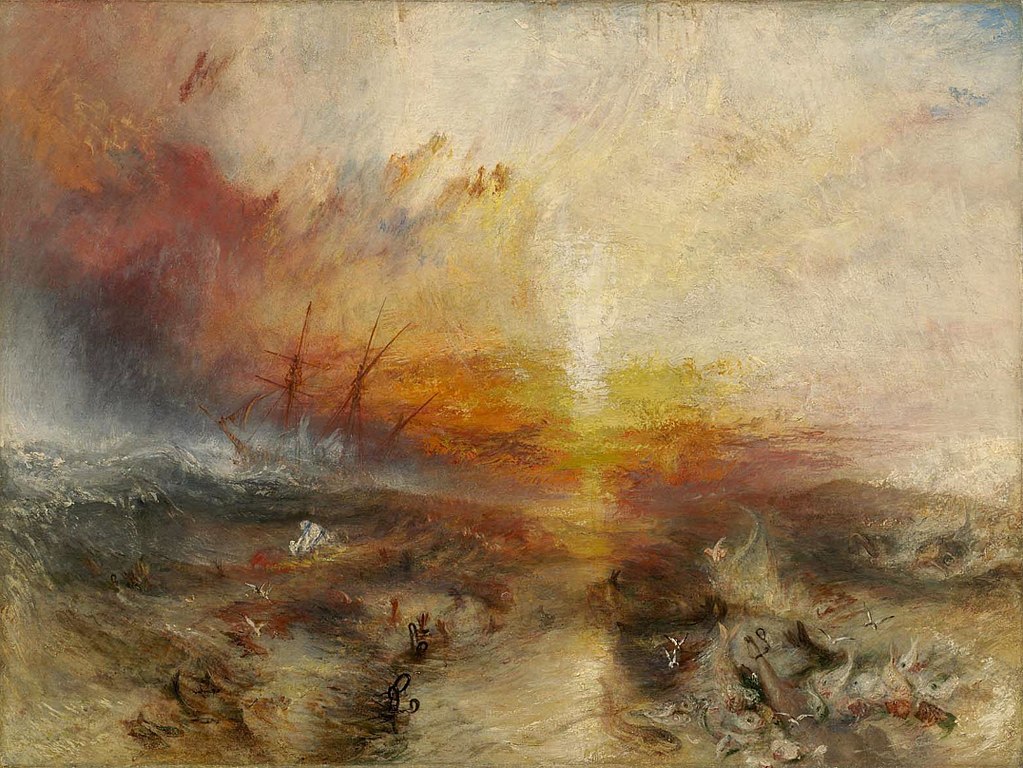By Lindsey Barrett and Davide Carozza

Inspired by Ian Baucom’s reading of J.M.W. Turner’s “Slavers Throwing overboard the Dead and Dying—Typhoon coming” in Specters of the Atlantic, this site will curate a small exhibit about different depictions of slavery in the visual arts. Baucom makes a sophisticated argument that demonstrates how Turner’s painting joins affect and epistemology, reconciling a number of binaries (interest and disinterest, abstraction and fact, melancholy and impartiality) into a new unity. In arguing that Turner is taking up a particular tradition, one based on spectatorship and sympathy, of response to trauma, specifically the Zong massacre, Baucom highlights how an artist must choose a particular orientation to the subject matter of his or her work. The purpose of this site is to compare a number of close readings of works of visual art in order to draw out the significance of this artistic choice. Consider, for example, the composition of Turner’s canvas. It simultaneously taps into the affect of depictions of tragedy and reduces, visually if not affectively, the slaves thrown overboard to a minor part of the painting. Specters of the Atlantic offers us a way of understanding this choice, and the many more that Turner makes.
This site will include a collection of close readings. But we would also like to step back from any particular painting and think comparatively about the different orientations to scenes of slavery that artists have chosen for their work. By using this comparative mode, an interesting observation about these artistic choices is generated: every time such a choice is made, it serves to reinscribe the problem of depicting the trauma of slavery. That is, it makes the viewer aware of the need for choice, of the impossibility of capturing the experience fully and neatly. Invariably, something is missing. Thus you’ll find here both a close reading of a number of different works that intrigue us and our attempt to show that the artistic choices these works make are shaped by fundamental realities and complications inextricably tied to their subject matter. We hope that the reader will think with us and challenge us on both levels of our analysis, within each individual work of art and as we reflect on the question of artistic vantage point more generally.
We offer two different curated collections the reader can follow. The first, on Radcliffe Bailey’s “Levitate” and “Windward Coast” and Jason de Caires Taylor’s “Vicissitudes”, begins here. At the bottom of each page you’ll find a link to the next, which you can follow until you reach the “Comparative Reflections” which finish the presentation.
The second begins here.
How to cite this project: “Depictions of the Middle Passage and the Slave Trade in Visual Art,” Written by Lindsey Barrett and Davide Carozza (2014), Deeps, The Black Atlantic, Duke University, http://sites.duke.edu/blackatlantic/ (accessed on (date)).
How to cite this page: Davide Carozza, “Depictions of the Middle Passage and the Slave Trade in Visual Art,” Deeps, The Black Atlantic, Duke University, http://sites.duke.edu/blackatlantic/ (accessed on (date)).